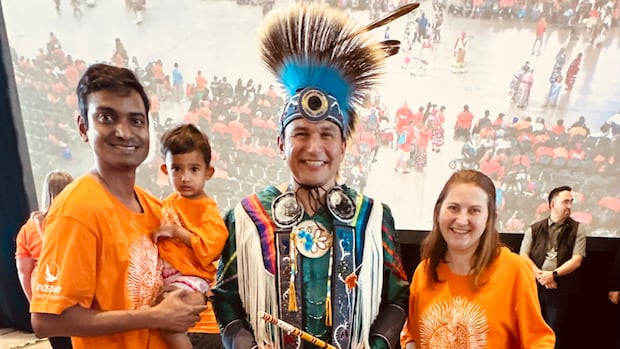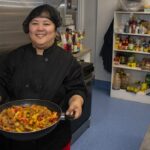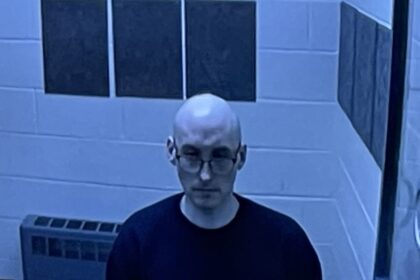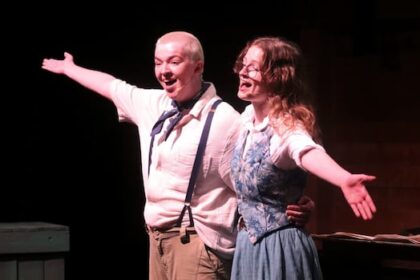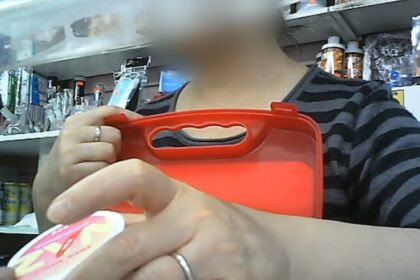Manitoba·First PersonWhen we moved to Canada, we left behind everything, including a war in Ukraine, in search of safety and opportunity. But with all the information we received, one critical piece was missing: any meaningful mention of the Indigenous Peoples whose land we now call home. ‘Honouring Indigenous truth is a responsibility for everyone living here,’ Itrat Anwar writesItrat Anwar · for CBC News · Posted: Nov 02, 2025 7:00 AM EST | Last Updated: 4 hours agoListen to this articleEstimated 4 minutesItrat Anwar, his wife, Halyna Kukurudz, and daughter Adeline pose with Manitoba Premier Wab Kinew at the Orange Shirt Day powwow. ‘We are learning and remembering every day, not just on Orange Shirt Day,’ he writes. (Submitted by Itrat Anwar)This First Person article is the experience of Itrat Anwar, a newcomer from Bangladesh who now calls Steinbach, Man., his home. For more information about CBC’s First Person stories, please see this FAQ. You can read more First Person articles here.Canada’s reputation as a peaceful and welcoming country brought my family and me here. We had left everything behind, including a war in Ukraine, in search of safety and opportunity.But amid all the information we received, one critical piece was missing: any meaningful mention of the Indigenous Peoples whose land we now call home.We weren’t told whose land we were living on. There was no explanation of what a land recognition meant or why it mattered. Terms like First Nations, Métis and Inuit were unfamiliar, mere labels without context.Even more troubling were the harmful stereotypes we encountered — blaming Indigenous people for social challenges or dismissing their struggles outright. Too often, conversations started with phrases like, “They always want something,” or “They brought it on themselves,” “They did it.”At first, we accepted these attitudes because we didn’t know better. But over time, I realized these attitudes reflect a deeper problem — a significant gap in truth, understanding and respect that shapes how newcomers perceive Canada’s history.My perspective shifted the day I visited the Canadian Museum for Human Rights. I had no idea what to expect, but the Indigenous Perspectives section left a profound impact on me.One moment stands out: I met an elderly Indigenous woman in tears after viewing the Indigenous history display. I gently asked if I could offer her a hug. She nodded. It was an emotional, powerful moment I will never forget. We weren’t told whose land we were living on.- Itrat AnwarThat visit sparked a journey of learning. I discovered that the land called Canada was not discovered — it was taken. I learned about the treaties that Indigenous leaders entered into, in good faith, but that were broken by the colonizers.I learned about the Indigenous children taken away from their families and placed in residential schools, forbidden from speaking their languages and stripped of their identities. I learned about the physical and emotional abuse, and that some children never returned home.This is not distant history. Our family learned that the last federally run residential school closed in 1996. I understand now that survivors still carry trauma that affects them and their communities.Halyna Kukurudz and daughter Adeline at the Orange Shirt Day powwow. (Submitted by Itrat Anwar)Since then, we’ve visited the National Indigenous Residential School Museum of Canada in Portage la Prairie and the historic site at Rocky Mountain House. And recently, we attended an event at the RBC Convention Centre in Winnipeg held to honour and support residential school survivors. We are still learning and remembering every day, not just on Orange Shirt Day. Many immigrants live here for decades without learning about residential schools or treaties.- Itrat AnwarThe more I learned, the clearer it became how invisible Indigenous histories remain to many newcomers. I noticed how quickly Indigenous individuals are judged in media headlines — often without understanding the deep trauma behind those stories. These views aren’t just opinions; they are rooted in ignorance and racism.For newcomers like me, arriving without knowledge of the land’s real history is dangerous. It keeps division and misunderstanding alive.Murray Sinclair, who was a senator, judge and chair of the Truth and Reconciliation Commission, put it simply when asked, “Why can’t they just get over it?””Why don’t you just remember it?” he replied.I believe that learning Indigenous history must be a core part of the newcomer welcome process and the permanent residency process — not just the citizenship knowledge test. Many immigrants live here for decades without learning about residential schools or treaties. This must change. To better ensure this, Indigenous history and rights education should be accessible in multiple languages, so no newcomer is left behind.Canada rightly prides itself on multiculturalism and welcome. But true inclusion means embracing all parts of our shared history, even the painful ones. Honouring Indigenous truth is a responsibility for everyone living here.ABOUT THE AUTHORItrat Anwar lives in Steinbach, Man., with his wife and children. He works with a community service organization supporting immigrants and refugees and is driven by a passion for human rights, kindness and inclusion. Itrat cherishes his family and loves discovering new places and learning about their cultures.
Sunday, 21 Dec 2025
Canada – The Illusion
Search
Have an existing account?
Sign In
© 2022 Foxiz News Network. Ruby Design Company. All Rights Reserved.
You May also Like
- More News:
- history
- Standing Bear Network
- John Gonzalez
- ᐊᔭᐦᑊ ayahp — It happened
- Creation
- Beneath the Water
- Olympic gold medal
- Jim Thorpe
- type O blood
- the bringer of life
- Raven
- Wás’agi
- NoiseCat
- 'Sugarcane'
- The rivers still sing
- ᑲᓂᐸᐏᐟ ᒪᐢᑿ
- ᐅᑳᐤ okâw — We remember
- ᐊᓂᓈᐯᐃᐧᐣ aninâpêwin — Truth
- This is what it means to be human.
- Nokoma


